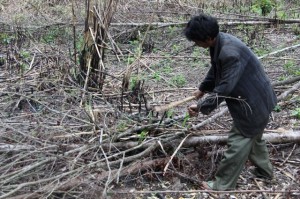Project Sekong 2012: CARE, our partner, has the livelihood projects well organized and we get good cooperation from villagers. We thank our lucky stars!

Our deminers can't properly search for UXO unless the land is cleared of brush. One indication of support for our work is that villagers keep cutting brush well ahead of our clearance team.
Report 9
I sat out under the stars for nearly an hour last night. We are so far removed from any light pollution that the night sky flaunts a lavish profusion of stars. We’re lucky in northern Wisconsin to have dark, star-studded skies but I can’t recall any night scene as striking as what I’m witnessing here.
Last night I was counting ordinary stars; today, my lucky ones. This project is off to a great start due to the confluence of several streams of good fortune.
CARE International, the non-government organization we’re partnering with has villagers well organized. Scrub cutters, men and women wielding machetes, are out each day in force, steadily clearing brush ahead of the deminers. True to our command, they’re cutting the scrub right down to four-inch stubble and, for the most part, pitching the cut vegetation off the path and out of our way.
We don’t always get such cooperation. For generations people here have practiced “swidden” or “slash and burn” agriculture in which the cut vegetation remains where it falls. When tinder-dry, that brush fuels a fire that consumes grass, leaves, felled timber and all other combustible refuse. Confirmed swiddeners no doubt view carrying away the cut vegetation as wasted labor.
Another lucky star is Chomrong Koy, our Team Leader. He has everyone up and moving up at the crack of dawn and then off to the field as soon as breakfast is finished. He keeps everyone focused on assigned duties and promptly whistles deminers back to work after their hourly 10-minute break. Chomrong brings a rare level of efficiency to clearance work. Our team leaders on previous projects have been knowledgeable explosive ordnance technicians, but not always the best managers of staff.
The greatest blessing we’ve enjoyed is the fact that the land we’re searching is relatively clear, not only of unexploded ordnance, but of any metal contamination whatsoever. No nails, no bottle caps, no wire, no discarded tools and, most significantly, no bomb fragments!
As a rule, its not the demolition of ordnance that slows a team down, it’s the necessity of investigating every piece of metal that triggers a signal from a detector. We typically investigate and remove hundreds, if not thousands, of bomb fragments per acre — refuse ranging from half the size of a dime to twice the size of a dinner plate.
While it’s tempting to ignore a weak signal from the detector and move on down the trail, a team is almost always obligated to excavate and explore. I’ve watched deminers cautiously dig and sift through soil for five minutes and come up with nothing more than a tooth-sized fragment of old bomb casing.
No matter how bad the metal contamination, there’s no alternative in proper clearance to just cracking on. If we neglect to properly search a spot the size of a ping-pong ball we could leave behind a deadly piece of ordnance.
One of the advantages of working with clearance animals, be they dogs, or rats, or wasps is that those creatures are conditioned to respond, not to the presence of metal, but to the scent of explosive. A sniffer dog, alert to the scent of TNT or other high explosive, will bypass thousands of pieces of frag that a deminer armed with a metal detector would be obliged to investigate.
We work under other lucky circumstances: pleasant weather, friendly villagers, a congenial team, well functioning equipment, and more. But, it’s early. And, this is Laos. It’s always a good idea here to think twice, and then think twice again, before you double down your bet.
